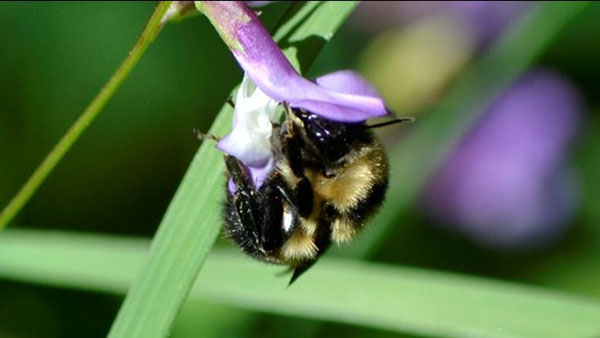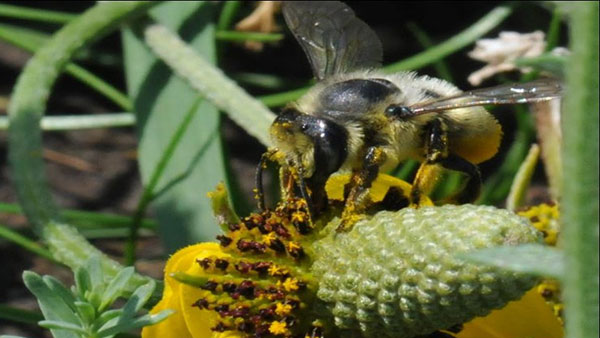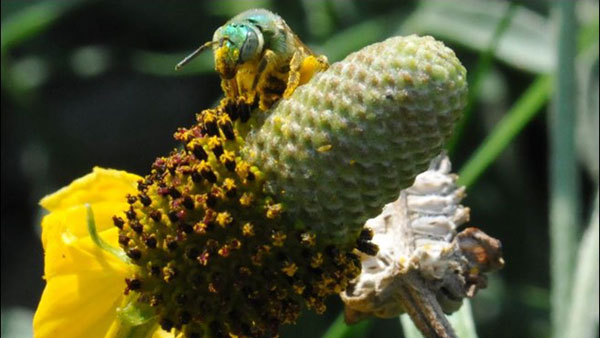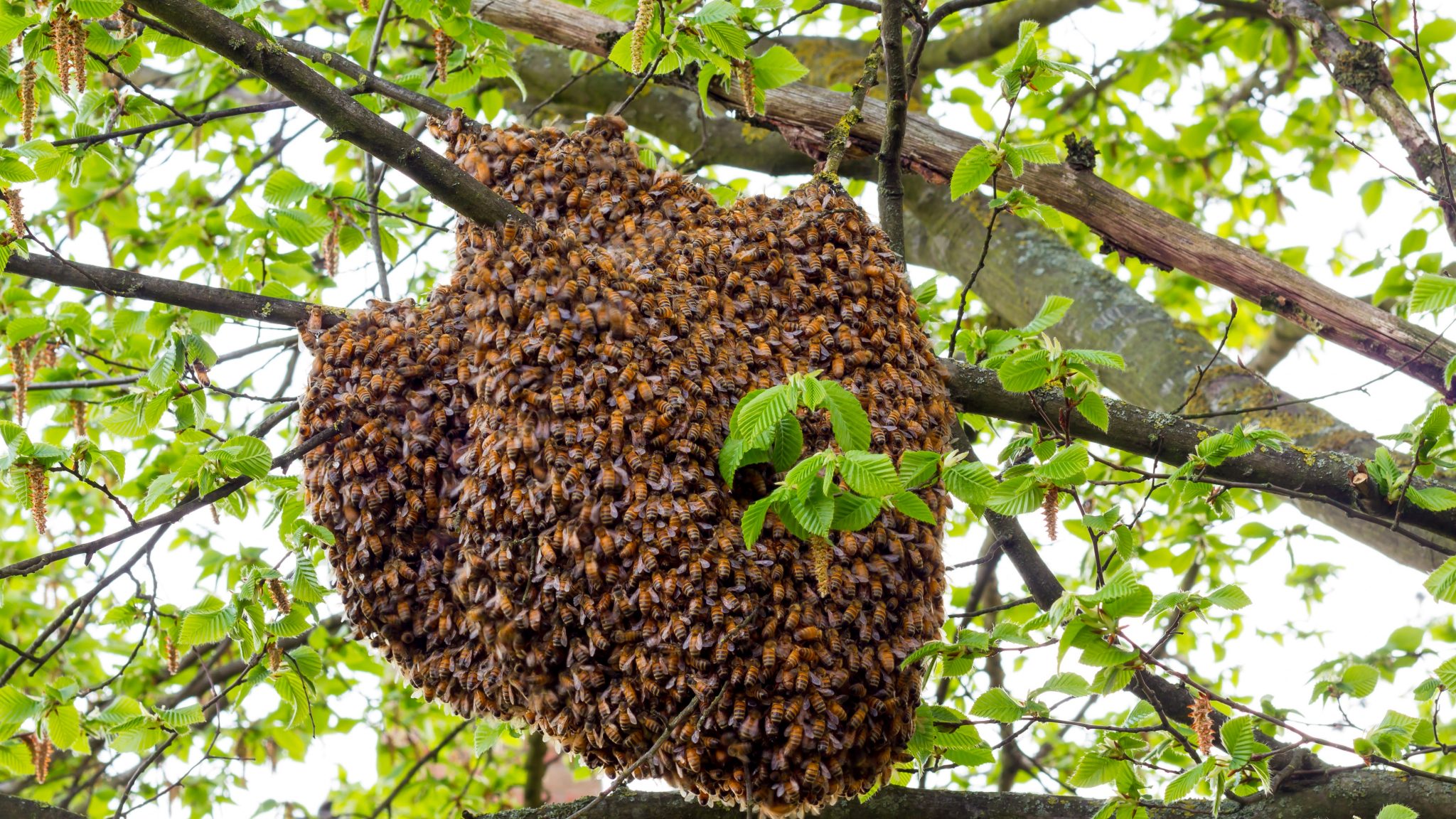Bees in Calgary
Bees play an important role in growing the food we eat every day. They spread pollen from flowers and plants that help seeds grow and keep the environment healthy.
But there are many threats facing bees today. Things like habitat loss, climate change and pesticide use have reduced our bee populations over time. Read more to learn about our local bees and how you can help them survive.
Bees in Alberta
Alberta is home to over 200 types of bees. They come in all colours and sizes. Some make their homes in the ground, others nest in tunnels or cavities. Unlike honeybees, which live in colonies and are known to swarm, most of our local bees live separately and are non-aggressive. Watch for these bees in your garden this spring.
How to help our bees
It’s important to protect our bees and their habitat. We are giving them homes and food by re-planting native plant species to our parks and green spaces. We also try to reduce the number of invasive plants. You can help bees in your community by:
- Adding bee-friendly plants to your garden;
- Leaving hollow stems and leaf litter in your yard over the winter; or
- Installing a mason bee house.
Urban beekeeping and licensing
Beekeeping is a successful and growing hobby in Calgary. The City of Calgary provides regulation and licensing for urban beekeeping. This helps address issues and create solutions for bees, beekeepers and neighbours.
Reporting bee swarms
According to the Calgary and District Beekeepers Association, bees
will swarm when they need more space. Swarms are a natural
way for bees to divide the hive. The association’s primary interest
is in protecting and rescuing honeybees.
For honeybee swarms, report the swarm by sending an email to calgarybeekeepers@gmail.com and describe the bee situation, include:
- Your phone number and a picture;
- Location of the swarm (street address);
- Height of the swarm (20 ft up a tree or on the ground).
For wasps or other insect issues, please contact a pest control company.
Bumblebees

- Have large, fuzzy black and yellow striped bodies.
- Make their nests out of waxy cells, usually in cavities or near the ground.
- Carry pollen in 'baskets' on their legs.
- Are responsible for pollinating strawberries, tomatoes and many types of native plants.
Leaf Cutter Bees

- Have wide heads and strong jaws for gathering nest materials. They are the sharks of the bee world!
- Prefer to lay its eggs in tunnels or cavities and seals its nest with pieces of cehwed leaves.
- Very important to the pollination of alfalfa and canola crops.
Masked Bees
- Are named for the yellow markings on their faces, shoulders and legs.
- Are small, mostly black and mostly hairless.
- Often mistaken for wasps.
- Store pollen inside their bodies in special pouches known as ‘crops’.
- Make their nests in cavities and line their homes with a plastic-like substance they make in their bodies.
Mason Bees
- Are metallic blue in colour.
- Carry pollen on their bellies.
- Make their nests in narrow tunnels like hollow plant stems.
- Lay their eggs in a separate chamber with walls made of mud.
- Are very active in early spring.
- Important for pollinating fruit trees.
Sweat Bees

- Are metallic in colour.
- Carry pollen on their legs.
- Are attracted to the salt in our sweat and will lick it off if given the chance!
- Prefer to make their homes on the ground in bare soil.
- Females dig underground burrows and lay eggs in separate tunnels.
- Are most active in the late spring and summer.
- Important for pollinating sunflowers and other wildflowers.
Swarms and Swarm catchers

- Honeybee swarms are usually docile, but should not be provoked.
Bee FAQs
How do I tell the difference between bees and wasps?
Is it interested in your food?
If so, it’s most likely a wasp. Wasps are meat eaters and are attracted to human food. Bees are vegetarians and eat nectar and pollen from flowers.
What does it look like?
Bees have round, hairy bodies with flat rear legs. If it’s carrying pollen on its belly or back legs, it’s a bee. Wasps don’t carry pollen and they have narrow, shiny bodies with thin waists. Their legs are shaped like cylinders.
Where is it located?
If it’s coming out of a mud or paper hanging nest hanging from your house or tree, it’s a wasp. If you see it on a flower, it’s most likely a bee.
I am scared of bees and wasps. How do I tolerate having them around me?
Most of our native bees in Alberta are solitary – these bees live alone and do not swarm. Solitary bees rarely sting and are not aggressive. To prevent wasps in your yard, ensure there are no food attractants available.
How do I encourage bees in my yard and prevent them from nesting in my house?
Many people are surprised to learn that about 70 per cent of Alberta’s bees nest in the ground. Some native bees, like mason and leaf-cutter bees, nest in narrow tunnels or small cavities. These types of bees prefer to use existing holes for their nests and typically do not create holes in structures.
To discourage bees from making their winter home in your home, ensure your fascia and soffit is properly attached at the roofline and that there is no rotting wood around doorways or decks. Consider providing appropriate nest sites (leaf litter, loose bark, flower stems, etc.) elsewhere in your yard.
Where do bees live?
The best place to find bees depends on the season and the type of bee. All our native bees hibernate during the winter.
Bumblebees are social and nest in seasonal colonies. Bumblebee queens’ mate in the fall; after laying eggs and producing workers in the spring, the worker bees care for the nest and gather pollen. Late in the summer the queen produces males and new queen bees. Only the mated queen bees survive over the winter.
Unlike bumblebees, solitary bees lay their eggs in the fall. Some nest in cavities and others nest underground in bare, dry soil. Female solitary bees lay eggs in individual cells. Each cell is provided with a portion of nectar and pollen before it is sealed shut with mud or leaves. Before winter sets in, the eggs hatch into larvae, which transform into adult bees that hibernate in their cells until the spring.
What is the difference between a solitary and social bee?
Social bees live in colonies and care for their young after they hatch. Solitary bees do not typically interact with other bees and the queens do not return to their nests after their eggs are laid in sealed cells.
What are the differences between managed and wild bees?
Managed bees are those that are tended by humans. Honey bees are the most common type of managed bee in the world. Honeybees live in large social colonies, are kept in enclosed hives and used for commercial crop pollination and honey production. If their hive is disturbed or their queen is threatened they can become very aggressive and territorial. Apart from bumblebees, all our native bees are solitary. They are not aggressive and tend not to socialize with other bees.
Photos courtesy of Lincoln Best and Michael Gavin

